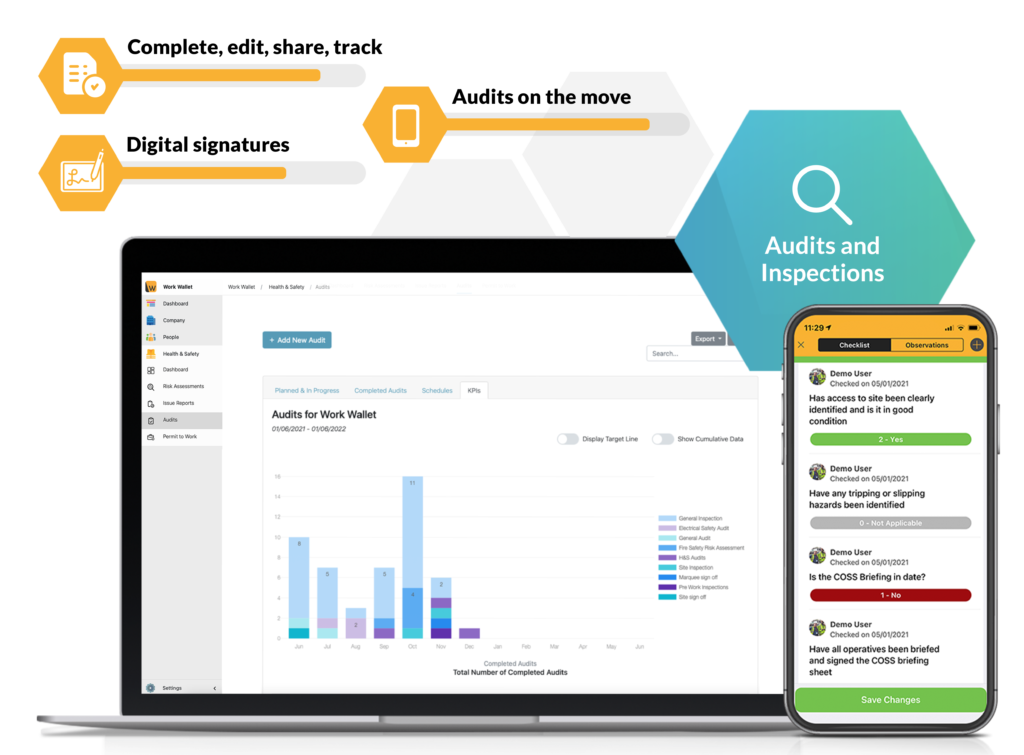What is a health and safety audit and why is it important?
A health and safety audit assesses your workplace policies, processes, procedures, and systems, highlighting areas for improvement.
20 July 2022

A health and safety audit is an assessment of the health and safety standards of an organisation.
It assesses your workplace policies, processes, procedures, and systems, highlighting areas for improvement.
Audits can feel like a chore without the right approach and systems in place. However, a good health and safety audit is much more that a defensive measure or simple tick-box exercise. You should view audits as a way to help to proactively improve your business, identifying areas for enhancement.
A good audit will assess aspects such as:
- Are you compliant with relevant laws and regulations?
- Are your policies easy to understand, and well communicated?
- Are your processes documented, and easy to follow?
- Do your safety systems work properly, and deliver the right outcomes?
- Do you adequately support health and wellbeing, as well as providing basic safety protection?
- How engaged is your workforce in your organisational safety culture?
This comprehensive approach means that a health and safety audit can be an extremely valuable tool for businesses of all sizes. It can help you to identify potential risks before they turn into costly accidents or incidents. And it can give you peace of mind of knowing that you are doing all you can to protect your employees, customers, and business.
Is a health and safety audit a legal requirement?
There is no legal requirement for businesses to conduct a health and safety audit. However, the Health and Safety Executive (HSE) guidance document HSG65 Successful Health and Safety Management recommends that audits are undertaken. Therefore, many businesses choose to do so as part of their commitment to health and safety best practice. In some industries, such as construction, regular audits may be a condition of insurance cover.
In short, you do not have to do a health and safety audit - but there are plenty of good reasons why you should.
The benefits of a good health and safety audit
 There are numerous benefits to be gained from undertaking a health and safety audit. These can be broadly divided into three main categories:
There are numerous benefits to be gained from undertaking a health and safety audit. These can be broadly divided into three main categories:
Improved safety
Let's start with the obvious one. Ultimately, the goal of a health and safety audit is to improve safety in the workplace. This can be achieved in a number of ways, including reducing accidents and incidents, improving communication of procedures, and engaging employees in your organisation's safety culture.
Compliance
A good health and safety audit will ensure that your business is compliant with relevant laws and regulations. This reduces the risk of prosecution, should an incident occur. It also helps to create a culture of compliance within your organisation, which can lead to improved standards across the board.
Cost savings
By identifying potential risks early on, you can avoid the costs associated with accidents and incidents. In addition, implementing the improvements suggested by an audit can lead to efficiencies and cost savings in other areas of your business. For example, better communication of health and safety procedures can save time wasted on repeatedly training employees who are unclear on what they should be doing.
As you can see, there are many good reasons to conduct a health and safety audit. And with the right approach, an audit can be an extremely valuable tool for any business.
Why should I do a health and safety audit?
As well as the benefits outlined above, there are a number of other reasons why you might choose to do a health and safety audit. These can include:
- To assess the effectiveness of your current health and safety management system
- To find out how well your employees understand and comply with health and safety procedures
- To identify any potential risks that could lead to accidents or incidents
- To help you develop and implement improvements to your health and safety management system
- To provide evidence of due diligence, should an incident occur
What does a health and safety audit cover?
 The scope of a health and safety audit will depend on the size and type of your business, as well as the industry you operate in.
The scope of a health and safety audit will depend on the size and type of your business, as well as the industry you operate in.
For example, you could audit your whole business, or a single division. Or you may want a global or wholistic overview, or you may want to audit a specific process or outcome. Regardless, there are some common elements that are often included, such as:
- An assessment of your compliance with relevant laws and regulations
- An evaluation of your health and safety policies, procedures, and systems
- An examination of how well your employees understand and comply with health and safety procedures
- A review of any accidents or incidents that have occurred in the past
- Identification of any potential risks that could lead to accidents or incidents in the future
How often should I carry out a health and safety audit?
This will depend on the size and complexity of your business, as well as the results of previous audits. There is no set timeframe for carrying out a health and safety audit. However, it is generally recommended that audits are conducted on a regular basis.
Many businesses therefore choose to conduct a health and safety audit at least once a year. However, if you have identified significant areas for improvement, you may wish to carry out more frequent audits until these improvements have been made.
This helps to ensure that improvements are embedded into your organisation. You can identify and address new risks in a timely manner.
How can I do a health and safety audit?
When it comes to conducting a health and safety audit, there are a number of different approaches you can take. You can choose to do it yourself, or you can bring in an external consultant.
You can also use health and safety software such as Work Wallet to digitalise the process, making audits quicker and simpler. Businesses are increasingly turning to health and safety software. This type of health and safety software or app provides an effortless way to manage audits, with features such as checklists, report generation, and action tracking.
Whichever approach you choose, the important thing is to make sure that your health and safety audit is comprehensive. Some fundamental aspects always need including, and it cannot be a tick box exercise. It needs to cover all aspects of your particular business, bespoke to your requirements. Only then will you be able to identify potential risks, and put in place measures to avoid them. Using flexible and configurable health and safety software will help significantly.
What is an internal audit?
 The HSE requires your internal health and safety audit to be conducted by a "competent person". This means “someone who has sufficient training and experience or knowledge and other qualities that allow them to assist you properly.”
The HSE requires your internal health and safety audit to be conducted by a "competent person". This means “someone who has sufficient training and experience or knowledge and other qualities that allow them to assist you properly.”
The employee who is your designated internal auditor should therefore be suitably qualified, for instance through NEBOSH or IOSH.
An internal health and safety audit is likely to be more cost effective. In addition, an internal audit has the advantage of increased control and oversight of the process. You can arrange audits and inspections so that they are less disruptive to business operations.
You data also stays within your organisation. It can be an effective and immediate management tool if done well, driving improvement.
What is an external health and safety audit?
An external H&S audit should be conducted on your behalf by a trained, experienced and qualified "competent person". They will almost certainly need to be a health and safety consultant.
The consultant will visit your business, and require access to your staff, your data, your systems, and your policies. They will use their expertise to spot gaps and improvements.
This approach could potentially be more comprehensive and insightful. However, it is likely to cost more and be more disruptive.
The best of both?
You can mix all three approaches, especially if you use the same software as your consultant. For example, health and safety consultants in various industry sectors use Work Wallet. Work Wallet can put you in touch with those consultants, for you to contract with directly.
If you both use Work Wallet's Audits & Inspections software, you benefit from easier communication. You keep control of your data, and your consultant can see it in real time, advising accordingly. You can do all this remotely, minimising disruption.
Why should I use Work Wallet?
No matter what approach you take, health and safety audits should be an important part of your business operations. By taking the time to assess your risks and identify areas for improvement, you can help to create a safer workplace for everyone involved.
Many consultants use Work Wallet, and you can too if you choose to do an internal audit. You may wish to use Work Wallet's Audits & Inspections software. This will make it quicker and easier for you to go through the process. Alternatively, if you are conducting an external audit, you can share data and documents in real time.
You can manage your organisation's health and safety flexibly and cost-effectively with Work Wallet's modular system. You only pay for the parts of the system you need, when you need them. Pricing is equally flexible, charged on a low per-user per-month basis.
If health and safety is important to your business, consider using Work Wallet's modular health and safety software today.
You can find out more about our products on our website, or by contacting us directly. You can also book in for a demo. We will be happy to answer any questions you have about our software, or about health and safety audits in general.
Share post
More Posts
How to create a health and safety audit template
Jul 2022
Creating a health and safety audit template can be a daunting prospect. How do you know where to start?
Why You Need a Health and Safety Management System
Jul 2022
Implementing an effective health and safety management system is an essential choice. But where do you start?




